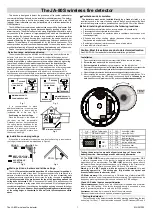
Maintenance
2030047-001A
Patient Data Module
5-7
Battery care
The Lithium-Ion battery is a rechargeable battery containing Lithium-Ion cells. Each
battery contains an integrated electronic fuel gauge and a safety protection circuit.
The processor within the equipment communicates with both the battery and the
charger.
The following are facts about Lithium-Ion battery technology:
The battery discharges on its own, even when it is not installed in the equipment.
This discharge is the result of the Lithium-Ion cells and the bias current required
for the integrated electronics.
The self-discharge rate doubles for every 10°C (18°F) rise in temperature.
The capacity loss of the battery degrades significantly at higher temperatures.
As the battery ages, the full-charge capacity of the battery degrades and is
permanently lost. As a result, the amount of charge that is stored and available for
use is reduced.
The following terms are used to define the battery capacity:
Design capacity — The theoretical capacity of the battery cells when the battery
is new.
Full charge capacity — The actual amount of charge the battery can store and
deliver.
Remaining charge capacity — The amount of full charge capacity currently
remaining in the battery. This is a percent of full charge capacity.
Use recommendations
GE recommends the following methods to improve battery performance:
Location — Position the equipment in a location that does not artificially
increase the operating temperature of the batteries.
Charging method — Whenever possible, use the Cadex SMart Two+ charger to
charge the battery. The Cadex SMart Two+ charger maintains a lower battery cell
temperature during the charge cycle. This reduction in temperature can extend
the life of the battery.
Conditioning guideline — Remove the batteries from the equipment every six
months and condition it using the Cadex SMart Two+ charger. This condition
cycle recalibrates the electronic fuel gauge.
Storage recommendations
Store the battery outside of the device at a temperature between 20°C to 25°C (68°F
to 77°F). Storing the battery inside the Patient Data Module is
not
recommended for
the following reasons:
In a device that is powered by an AC power source, the battery cell temperature
increases by 10°C to 15°C (18°F to 27°F) above the room’s ambient temperature.
This reduces the life of the battery.
Summary of Contents for PDM
Page 7: ...2030047 001A Patient Data Module 1 1 1 Introduction ...
Page 13: ...2030047 001A Patient Data Module 2 1 2 Equipment Overview ...
Page 21: ...2030047 001A Patient Data Module 3 1 3 Installation ...
Page 26: ...3 6 Patient Data Module 2030047 001A Installation ...
Page 27: ...2030047 001A Patient Data Module 4 1 4 Service Tool and Configuration ...
Page 38: ...4 12 Patient Data Module 2030047 001A Service Tool and Configuration ...
Page 39: ...2030047 001A Patient Data Module 5 1 5 Maintenance ...
Page 48: ...5 10 Patient Data Module 2030047 001A Maintenance ...
Page 49: ...2030047 001A Patient Data Module 6 1 6 Troubleshooting ...
Page 54: ...6 6 Patient Data Module 2030047 001A Troubleshooting ...
Page 55: ...2030047 001A Patient Data Module 7 1 7 Field Replaceable Units ...
Page 69: ...2030047 001A Patient Data Module A 1 A Appendix A Technical Specifications ...
Page 80: ...A 12 Patient Data Module 2030047 001A Appendix A Technical Specifications ...
Page 81: ...2030047 001A Patient Data Module B 1 B Appendix B Electromagnetic Compatibility ...
Page 90: ...B 10 Patient Data Module 2030047 001A Appendix B Electromagnetic Compatibility ...
Page 91: ......
















































